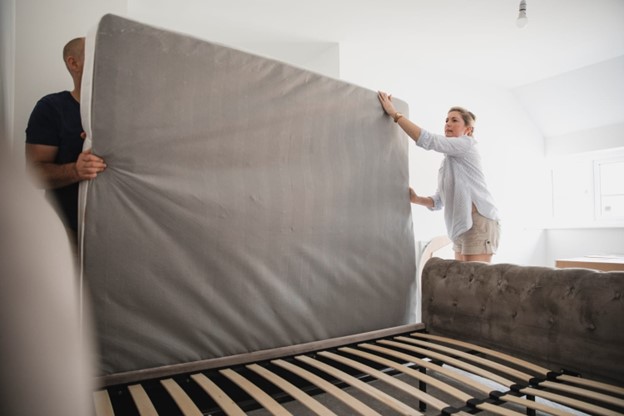I’ll never forget the moment I mastered mattress shifting. My mother gave me the mattress of my dreams when I began my second year of college. She insisted on it as a present and referred to it as an investment. I initially thought the concept was absurd. The joke is on me, though, as I still fantasize about that mattress more than ten years after we broke up
.
The mattress quickly evolved into one of my must-have goods every time I relocated, whether I was simply moving across town or completely across the nation. Who ever imagined that relocating a mattress would be of such importance? Who? Anyone who has ever valued a restful night’s sleep (and consequently, their health), thinks a quality mattress is an excellent investment or doesn’t have the additional funds for a brand-new bed.
Real talk: relocating every mattress you possess is probably not worth the trouble. However, if you find yourself with a mattress that you plan to keep, here are our top suggestions for moving and storing a mattress while keeping it in excellent, sleep-worthy condition.
A DIRECTIVE FOR MOVING A MATTRESS
To transfer a mattress successfully, swiftly, safely, and easily, follow these eight steps.
Measure your mattress as a first step.
Take out your measuring tape! Knowing a mattress’ precise dimensions is just as important as knowing its typical size (twin, double, full, queen, or king). This will help you choose the optimum moving approach, moving technique, and storage location, as well as the size of the mattress bag you’ll need.
Step 2: Compile all of your materials.
Mattress bags, moving tape, scissors, straps or ropes to fasten the mattress, and a mattress dolly is among the supplies you’ll need. (A complete list of supplies is provided below.)
Step 3: Verify there is an adequate workspace.
Give yourself extra space so you can get your mattress ready to move. A packing pro tip is to pack your mattress last so that it may be used as a bed the night before you move and that space can be cleared in the room.
Step 4: Recruit assistance (or two).
Mattresses are bulky, and uncomfortable, and they like to bounce about. If you’re attempting to move your mattress on your own, don’t. Even seasoned movers utilise a team approach when transporting a mattress. Instead, make an effort to seek the assistance of a friend, neighbour, or relative. In addition, if you want professionals to handle more heavy lifting, you may hire help through a freelancing labor service like TaskRabbit or Handy or pay hourly moving assistance.
5. Put your mattress in a sturdy mattress bag in step 5.
If you’re moving your mattress or placing it in storage, this will assist to protect it. Moving mattress bags are available in conventional mattress sizes, but to ensure the bag will fit your mattress, you’ll need to know how deep it is. You may use one of them for your box springs as well because they often come in batches of two.
6. Clear a route so you can move the mattress in step six.
Remove any breakables you may come across along the route, such as lamps, portraits that are hung on the wall, or anything else that may fall victim to a shaky mattress.
Step 7: Turn the mattress so it is simpler to transport by turning it on its side.
This often entails rotating the mattress horizontally so that it is longer than it is tall. Moving a flat-positioned mattress is uncommon, especially because you’ll probably need to squeeze through doors.
Step 8: Fill up any gaps with the mattress.
One of a mattress’ main benefits is its form; it may easily fit in tight areas. Lay your mattress on its side and slide it into the gap you left between your belongings and the container’s wall. This ensures simple access once you get at your new residence; the quicker you unload, the sooner you can take a power sleep.
Only do this if you intend to unload swiftly. The mattress will become deformed if you keep it standing horizontally for about a month. Put your mattress flat on top of a firm surface if you need to store it for a time. It won’t distort as a result over time.
9. Load the mattress and fasten it.
Whether at all feasible, ask your manufacturer if there are any specific transit recommendations because mattress configuration might vary. The following general movement position suggestions are listed by type:
- Position a traditional innerspring or enclosed coil mattress lengthwise or flat on top of a level surface (similar to how you would while you sleep), with nothing on top.
- Hybrid or memory foam: Place flat, with nothing on top of it, on top of a level surface.
- Box springs: Nothing should be put on top of them (unless it’s the mattress), and they can be placed flat or on their side.
Important information: All mattress types should be placed flat for storage. (See below for our storage advice.)
